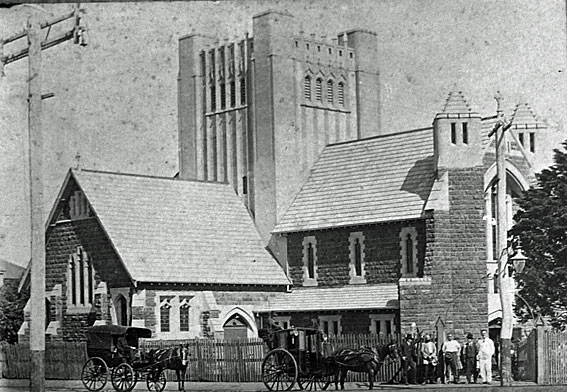
St Andrew's Anglican Church, Clifton Hill: church exterior from north
[photograph from church file, State Library of Victoria]

St Andrew's Anglican Church, Clifton Hill: church exterior from north
[photograph from church file, State Library of Victoria]
Historical and Technical Documentation by John Maidment
© OHTA (last updated October 2014)
St Andrew's Church was constructed in reinforced concrete and bluestone to the designs of North & Williams. The foundation stone was laid on 4 March 19161 and the building dedicated on 30 September of that year. It cost £10,000 to erect.2 Some of the materials from an earlier church by Twentyman & Askew were incorporated.3 The building was notable particularly for its colossal concrete central tower, the soaring nave with tall clerestory rising above narrow passage aisles, and the western façade, flanked by obliquely placed square turrets. Not for nothing was it known as the "young cathedral." Sadly, owing to delamination of the concrete, it was decided by Bishop Sampbell that the building should be demolished, which took place in 1975. This was a very short sighted decision which has been regretted ever since as this was one of the most imaginative church designs of the period.

St Andrew's Anglican Church, Clifton Hill: the organ case
[photograph by Christopher Hill (1974)]
The organ was built in 1868 by George Fincham for All Saints' Anglican Church, East St Kilda, consisting of Swell and Pedal Organs, and a Choir Organ was added in 1871.4 The concept of having two such accompanimental divisions was devised in England by the Revd F.H. Sutton,5 and was also put into practice by Fincham at Christ Church, Daylesford. The Swell consisted of a complete chorus to Mixture, with a Trumpet, and the Choir more delicate stops, but with a chorus to 2ft. The console incorporated two unique brass departmental labels, lettered in Old English script.
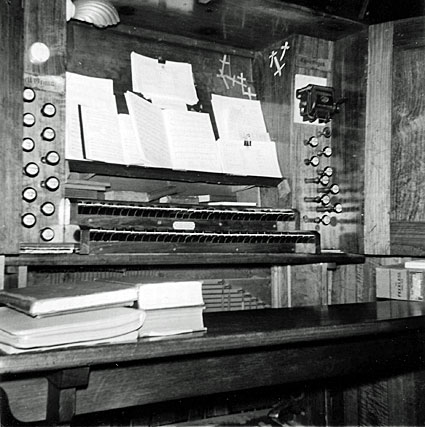
St Andrew's Anglican Church, Clifton Hill: the console
[photograph by W.G.S. Smith (c.1970)]
| CHOIR Clarabella Viol de Gamba Dulciana Gemshorn Flute Piccolo Cremona Swell to Choir SWELL Double Diapason Open Diapason Stopd Diapason Clarabella Keraulophon Principal Flute Fifteenth Sesquialtera Trumpet Oboe PEDAL Open Diapason Choir to Pedal Swell to Pedal |
8 8 8 4 4 2 8 16 8 8 8 8 4 4 2 III 8 8 16 |
(unenclosed – 1871) TC (probably a Bell Gamba) bass in façade (1868) CC-BB TC TC TC 17.19.22 |
Compass: 56/29
3 composition pedals to Choir
3 composition pedals to Swell
Lever swell pedal
Mechanical key and stop action
Attached drawstop console6
1 The Age, 6 March 1916, p.6
2 The Argus, 2 October 1916, p.9
3 Personal communication Louis Williams to John Maidment 1978
4 E.N. Matthews, Colonial Organs and Organbuilders (Carlton: Melbourne University Press, 1969), p.148; The Argus, 29 October 1868, p.5; The Argus, 26 January 1872, p.4
5 See the work: Frederick Heathcote Sutton, Church Organs: their Position and Construction. 3rd ed. London: Rivingtons, 1883, as republished Oxford: Positif Press, 1998. See examples of this at Brant Broughton (p.27), Plumtree (p.33), Worting (p.35)
6 Specification noted by John Maidment 1966
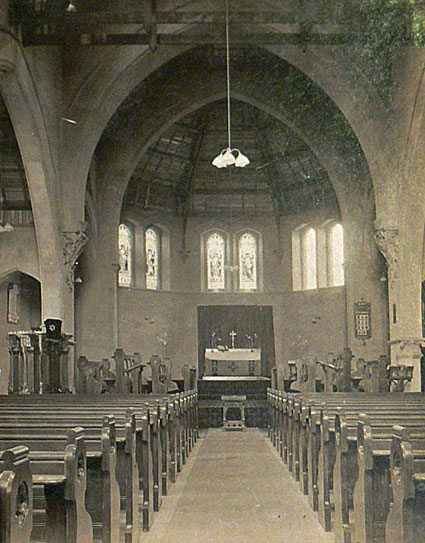
St Andrew's Anglican Church, Clifton Hill: church interior looking towards altar
[photograph from church file, State Library of Victoria)]
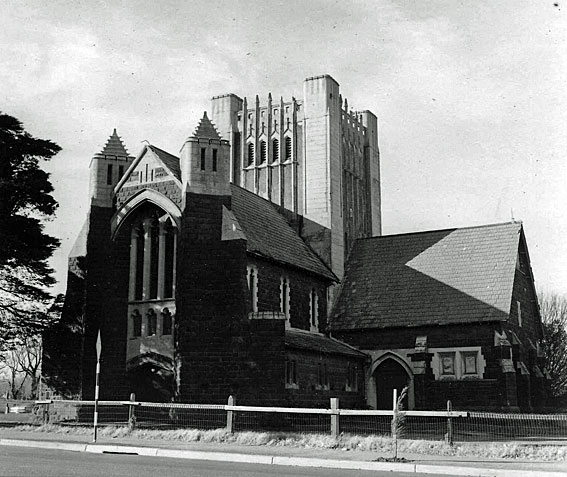
St Andrew's Anglican Church, Clifton Hill: church exterior from south-west
[photograph by John Maidment (1975)]
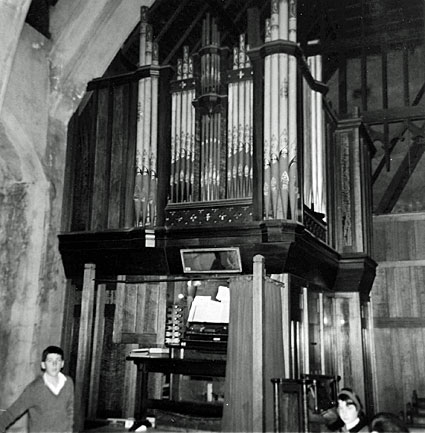
St Andrew's Anglican Church, Clifton Hill: organ
[photograph by W.G.S. Smith (c.1970)]